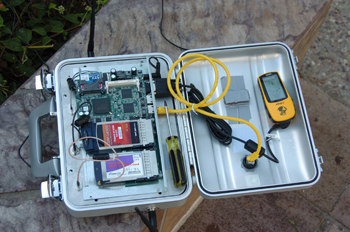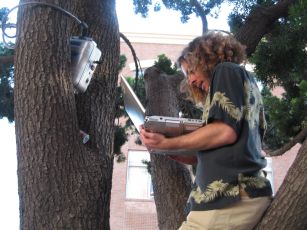CalMesh: Mesh Network Supports Emergency-Response Communications during Operation College Freedom
San Diego, CA, August 18, 2006 -- Next Tuesday, August 22, the home of Calit2's UCSD division, Atkinson Hall, will play the part of the front line in the war on terrorism. Calit2 researchers will deploy the latest wireless mesh network which will handle potentially life-saving data communications during this emergency preparedness exercise.
|
CalMesh provides the foundation for this communications infrastructure. Developed by the Response to Crises and Unexpected Events (RESCUE) and ResponSphere projects at Calit2, CalMesh is designed to be rapidly deployed at the site of a crisis to restore the communication fabric crucial to emergency response.
Operation College Freedom is a drill of the San Diego Metropolitan Medical Strike Team (MMST). MMST is a team of local, state, and federal responders who work together to develop and implement response plans for major urban crises and disasters. They have one major full exercise each year, and this year it is in Atkinson Hall. San Diego city and county public safety personnel from the police, fire and sheriff departments, SWAT, HAZMAT, and the Metropolitan Medical Response Service, as well as UCSD will be participating.
Numerous Calit2 projects will use CalMesh on Tuesday to deploy, test and evaluate their new applications and emerging technologies for the management of disaster and mass casualty situations.
The Wireless Internet Information Systems for Medical Response in Disasters (WIISARD), will showcase its mass-casualty tracking, triage and medical information management system. The WIISARD system combines state-of-the-art data collection and display devices, database services and 802.11 wireless communications to produce a consistent, real-time view of the disaster scene.
Although not specifically developed for WIISARD, CalMesh is the first step in a WIISARD deployment. CalMesh creates a wireless communications network at the scene. It is an ad-hoc network of small, lightweight, and easily reconfigurable nodes that quickly self-organize to form a reliable 802.11 wireless mesh network. GPS units attached to it can estimate people's position by triangulating the signal strength.
For Tuesday's drill, seven or eight CalMesh nodes will be placed throughout the mock disaster area creating a wireless bubble of network and Internet connectivity. Access to the Internet is achieved via a gateway node which is connected to both the wireless mesh and the UCSD wired network. The gateway node will be located on the roof of Atkinson Hall. A link to the technical specifications for CalMesh is below.
|
CalMesh has previously been deployed and used in conjunction with numerous demonstrations, drills and exercises. It made its public safety debut at the MMST drill in Carlsbad, CA on May 12, 2004, in affiliation with a WIISARD demonstration.
Live demonstrations reveal areas for improvement and lessons are learned; with each successive exercise, the nodes' robustness, stability and features have been improved. For this drill, there are two significant new features to CalMesh.
There are now two radios in each CalMesh node, on separate channels. A primary result is that it provides redundancy to CalMesh, a very important feature in the ever-changing scene of an emergency or disaster. Previous configurations had only one network card which served as the access point to client applications and performed the mesh networking and back haul functions. The load is now distributed between the two cards, essentially creating parallel networks.
Depending on interference, there should be an increase in capacity as well. The new configuration also means that more options are available. For example, CalMesh can now create directional links, including long, strong ones, in addition to a bubble of connectivity.
|
A tool to visually monitor the CalMesh network was just recently developed. The program measures and displays the signal strength from each node to each of the other nodes in the mesh. The signal strength between every pair of nodes in the mesh is available in a matrix view, with the ability to choose to view configuration details. Three tables are available: a matrix of each and a combined view of the CalMesh internal parallel networks.
"That's fantastic," said Leslie Lenert, the principal investigator of WIISARD, who saw the signal measurement tool for the first time this week. "This shows the health of the network." Lenert is also an associate director of the UCSD Division of Calit2 and a professor of medicine at UCSD's School of Medicine. Student researcher Alan Fung developed this tool in a very short time. He worked with RESCUE and ResponSphere researchers Brian Braunstein and Rajesh Mishra, the principal development engineer for wireless networking at the UCSD division of Calit2.
Related Links
CalMesh home page
CalMesh Technical Specifications
August 22, 2006 MMST Exercise



